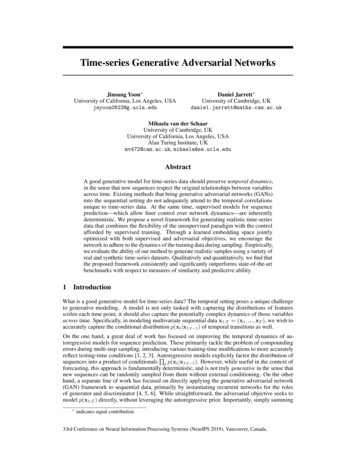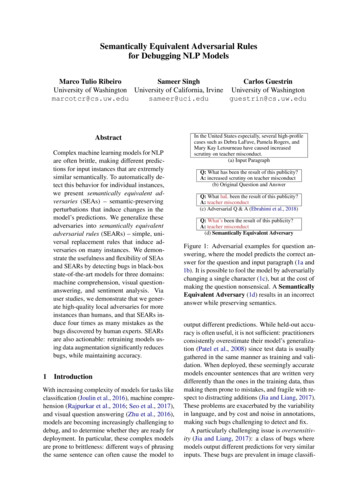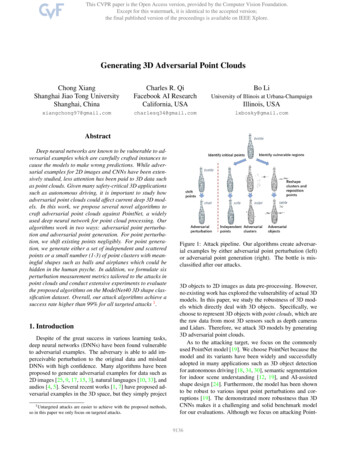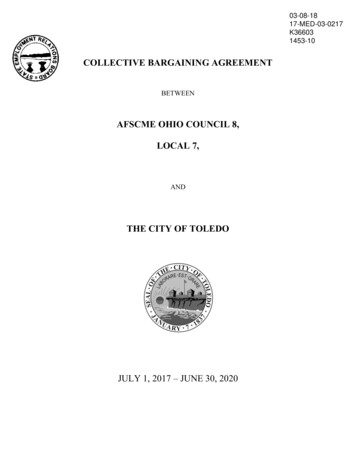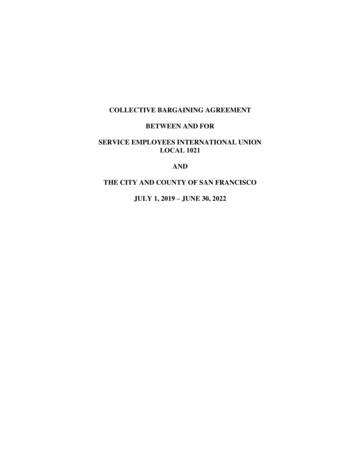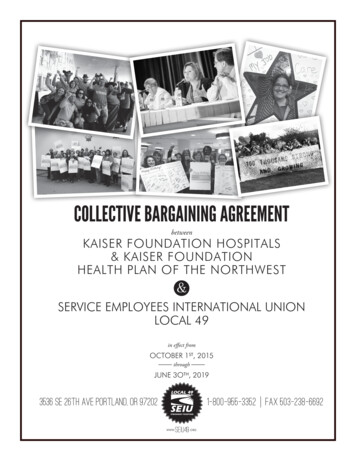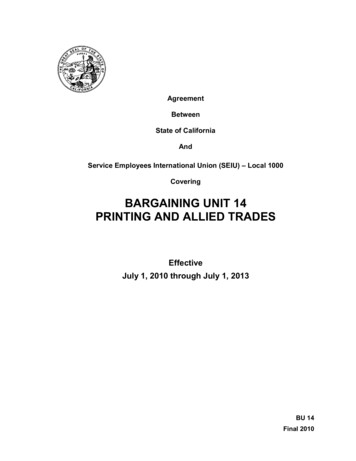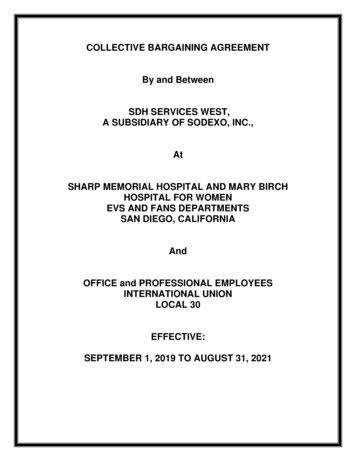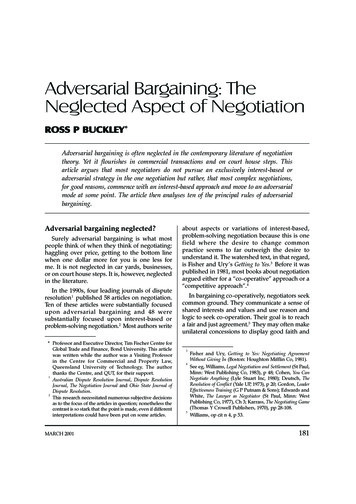
Transcription
ROSS P BUCKLEYAdversarial Bargaining: TheNeglected Aspect of NegotiationROSS P BUCKLEY *BUCKLEYAdversarial bargaining is often neglected in the contemporary literature of negotiationtheory. Yet it flourishes in commercial transactions and on court house steps. Thisarticle argues that most negotiators do not pursue an exclusively interest-based oradversarial strategy in the one negotiation but rather, that most complex negotiations,for good reasons, commence with an interest-based approach and move to an adversarialmode at some point. The article then analyses ten of the principal rules of adversarialbargaining.Adversarial bargaining neglected?Surely adversarial bargaining is what mostpeople think of when they think of negotiating:haggling over price, getting to the bottom linewhen one dollar more for you is one less forme. It is not neglected in car yards, businesses,or on court house steps. It is, however, neglectedin the literature.In the 1990s, four leading journals of disputeresolution1 published 58 articles on negotiation.Ten of these articles were substantially focusedupon adversarial bargaining and 48 weresubstantially focused upon interest-based orproblem-solving negotiation.2 Most authors write* Professor and Executive Director, Tim Fischer Centre forGlobal Trade and Finance, Bond University. This articlewas written while the author was a Visiting Professorin the Centre for Commercial and Property Law,Queensland University of Technology. The authorthanks the Centre, and QUT, for their support.1Australian Dispute Resolution Journal, Dispute ResolutionJournal, The Negotiation Journal and Ohio State Journal ofDispute Resolution.2This research necessitated numerous subjective decisionsas to the focus of the articles in question; nonetheless thecontrast is so stark that the point is made, even if differentinterpretations could have been put on some articles.MARCH 2001about aspects or variations of interest-based,problem-solving negotiation because this is onefield where the desire to change commonpractice seems to far outweigh the desire tounderstand it. The watershed text, in that regard,is Fisher and Ury s Getting to Yes.3 Before it waspublished in 1981, most books about negotiationargued either for a co-operative approach or a competitive approach .4In bargaining co-operatively, negotiators seekcommon ground. They communicate a sense ofshared interests and values and use reason andlogic to seek co-operation. Their goal is to reacha fair and just agreement.5 They may often makeunilateral concessions to display good faith and345Fisher and Ury, Getting to Yes: Negotiating AgreementWithout Giving In (Boston: Houghton Mifflin Co, 1981).See eg, Williams, Legal Negotiation and Settlement (St Paul,Minn: West Publishing Co, 1983), p 48; Cohen, You CanNegotiate Anything (Lyle Stuart Inc, 1980); Deutsch, TheResolution of Conflict (Yale UP, 1973), p 20; Gordon, LeaderEffectiveness Training (G P Putnam & Sons); Edwards andWhite, The Lawyer as Negotiator (St Paul, Minn: WestPublishing Co, 1977), Ch 3; Karrass, The Negotiating Game(Thomas Y Crowell Publishers, 1970), pp 28-108.Williams, op cit n 4, p 53.181
ADVERSARIAL BARGAINING: THE NEGLECTED ASPECT OF NEGOTIATIONin the belief that this imposes a moral obligationon the other party to reciprocate.6In bargaining competitively, negotiators makehigh initial demands and few and smallconcessions. They use exaggeration, threat andbluff to put pressure on the other side. Theirgoal is to win, both for the substantive outcomeand the intrinsic satisfaction they derive fromwinning.7 Unilateral concessions are viewed asa sign of naïveté and weakness.bargaining, or in their terms principlednegotiation , as an answer to the contest betweenthese two approaches. Principled bargaining waspromoted as the one-size-fits-all approach.Interest-based negotiations of the kindpopularised by Fisher and Ury can berepresented by the first three stages of thefollowing diagram.10Fisher and Ury changed the game and thedebate. They did not discover interest-basedbargaining that honour may go to Mary ParkerFollet writing in 19428 or to even earlier writers however, they did popularise it.Co- operative bargaining shares somecharacteristics with interest-based bargaining.However, the latter is a more structured processthat focuses on the identification of interests, thegeneration of options and the use of objectiveexternal criteria or processes to resolve disputes.Interest-based bargaining counsels againstmaking unilateral concessions and relying ontrust to resolve conflict.9 Competitive bargaining,on the other hand, is basically the same asadversarial bargaining.The literature pre-Getting to Yes was acontinuing debate of the relative virtues of cooperative and competitive bargaining. Fisher andUry presented their model of interest-based6789Osgood, An Alternative to War or Surrender (Urbana, Ill:University of Ill Press, 1962).See Williams, op cit n 4, pp 48-49; Morley andStephenson, The Social Psychology of Bargaining (GeorgeAllen & Unwin, 1977); Siegel and Fouraker, Bargainingand Group Decision Making (McGraw Hill, 1960); Simons,Persuasion, Understanding, Practice and Analysis (1976);Harnett, Cummings and Hammer, Personality,Bargaining Style and Payoff in Bilateral MonopolyBargaining Among European Business Managers (1973)36 Sociometry 325.Mary Parker Follet wrote Dynamic Administration (acollection of papers) in 1942, see Davis, An Interviewwith Mary Parker Follett (1992) 3 ADRJ 7 at 8-9.Fisher and Ury, Getting to Yes: Negotiating AgreementWithout Giving In (2nd ed, New York: Penguin Books,1991), p 21.182The vertical axis represents time, starting at thetop and progressing downwards; the horizontalaxis represents the breadth of potential interests,options and outcomes. The diagram widens inthe first three phases as there will virtuallyalways be more interests than issues, and moreoptions than interests. After the mid-point ispassed, the diagram narrows because options arethen being reality-checked and some discarded.The dotted lines in the final phase represent thatthe final outcome will fall somewhere within therange of acceptable options depending upon thespecific bargaining and choices of the parties.10This is an amplification of the two-triangles diagramwidely used in the early days of mediation courses. Icannot locate the origin of that diagram but expressgratitude to its creator nonetheless: it, and this extensionof it, have proven most helpful in teaching negotiationcourses over the years.THE AUSTRALIAN LAW JOURNAL Volume 75
ROSS P BUCKLEYGetting to Yes is a book about the top threeparts of the diagram: about identifying interests,generating options to address those interests andreaching agreement on which of the options willbe adopted. However, as life teaches us, this isnot the whole story. The fourth part of thediagram, adversarial haggling, is an unavoidableand critical part of most negotiations.Fisher and Ury s model offers, in most types ofnegotiations, major potential improvement inoutcomes over purely adversarial or co-operativebargaining. And, as such, I have no dispute withit. Indeed, if Fisher and Ury had been clearer aboutthe limits of their book they would have avoidedmost of the criticism it has attracted.11 However,they have presented their theories as if they arethe whole story and as if adversarial bargaining issomehow distasteful and can be avoided most ofthe time. It is not, and cannot be.Certainly, adversarial bargaining can be difficult,confronting and unpleasant and an aversion to itis probably the source of the fervour that gripsmany writers and theorists on negotiation.However, we cannot avoid adversarial bargainingif we wish to present a complete picture of thenegotiation process. Most negotiations will endwith some element of haggling over price or termsbecause, while a focus on interests and optionsmay well create value, the parties will still need todivide it between them.12Interestingly, most books on negotiation postGetting to Yes (if accepting adversarial strategiesas legitimate at all) present interest-basedand adversarial strategies as alternatives to be111213Unless, of course, one takes the view that it is simplyimpossible to expect other members of the academy torefrain from sniping at any book that sells so indecentlywell.Goodpaster, A Guide to Negotiation and Mediation(Irvington-on-Hudson, NY: Transnational Publishers Inc,1997), p 102.Inns of Court School of Law, Negotiation (London:Blackstone Press, 1996); see also eg, Susskind andCruikshank, Breaking the Impasse (Basic Books Inc, 1987),pp 15-34; Rubin, Pruitt and Hee Kim, Social Conflict(McGraw-Hill, 1986); Hocker and Wilmot, InterpersonalConflict (Wm C Brown Publishers, 1985).MARCH 2001chosen between and pursued throughout anegotiation.13 Some books include co-operativebargaining as a third potential strategy.14 Ineither case, the strategies are presented as either/or choices not as options for phases of the onenegotiation. This is a false choice. Obviously anegotiator can choose to pursue either strategyand stick with it from the beginning to the endof a particular negotiation. However, the far morecommon practice, particularly in complexcommercial negotiations, is for some variant onan interest-based, problem-solving approach tocharacterise much of the early bargaining andfor an adversarial approach to characterise muchof the concluding stages.15 The theorists aregetting caught up in the purity of their theories.It is usually appropriate to begin with aninterest-based approach (it is always easy tomove a negotiation into adversarial mode, muchharder, though possible, to move it from anadversarial to an interest-based process). Anegotiation that commences and proceeds ininterest-based mode will probably conclude withcompeting claims for a fixed resource. It isusually best to steer the process away from thisend game until interests and options have beenthoroughly canvassed. This is because anexamination of interests and options will oftenresult in an improved outcome for both partiesand because the process of doing so will oftenimprove the relationship between the parties sothat it is able to endure the unavoidabletoughness of adversarial bargaining. However,once the end game is reached, an adversarialstrategy is usually required to achieve the bestresult and an attempt to avoid conflict at thispoint will often lead to a less than optimal result.The neglect of adversarial bargaining in thescholarly literature would be reasonable if it were14Halpern, Negotiating Skills (London: Blackstone Press,1992); Goodpaster, op cit n 12 (each considers threestrategies: competitive, co-operative and principled/problem-solving).15See Buckley, The Applicability of Mediation Skills tothe Creation of Contracts (1992) 3 ADRJ 227 for adescription of the negotiation.183
ADVERSARIAL BARGAINING: THE NEGLECTED ASPECT OF NEGOTIATIONa less powerful theory superseded by Fisher andUry s new theory (as happens regularly in thenatural sciences). And the authors presentationof their ideas as a new paradigm has doubtlesspromoted this perspective. However, as we haveseen, in nearly all cases in real life, Getting to Yesdoes not fulfil the promise in its title. Its theoriesand techniques will certainly get one close to yes much of the time, but it will be oldfashioned haggling over price and terms thatwill get one to agreement most of the time.16The contemporary scholarly neglect ofadversarial bargaining could also be becausenothing more remains to be learned about theprocess; the literature pre-Getting to Yes may tellus all we need to know. A nice idea, but notcorrect. Research into negotiations in thepersonal injury context, such as Hazel Genn sexcellent book, Hard Bargaining,17 and Rob Davis fine article, Negotiating Personal InjuryCases ,18 reveals how much more there is tolearn about this topic. Many books pre-Gettingto Yes were simply collections of techniques andtactics written to appeal to a mass, not ascholarly, audience. Their pages were usuallyunburdened by theory or analysis.19So the initial purpose of this article is to issuea challenge to other researchers: adversarialbargaining is a crucial topic, worthy of study,about which there is much we still need to learn.16Compare Wade, The Last Gap in Negotiations: Why isit Important? How can it be Crossed? (1995) 6 ADRJ 93(focused entirely upon getting parties to agree, thisarticle is about strategies to cross the last gap, not aboutinterest-based methods).17Genn, Hard Bargaining: Out of Court Settlement in PersonalInjury Actions (Oxford: Clarendon Press, 1987).18Davis, Negotiating Personal Injury Cases: A Survey ofthe Attitudes and Beliefs of Personal Injuries Lawyers (1994) 68 ALJ 734.19See eg, Cohen, op cit n 4; Gordon, op cit n 4; notableexceptions being, Deutsch, op cit n 4; and Karrass, opcit n 4, (both of which give highly theoretical discussionsof adversarial tactics).184Negotiating consumes a large portion of eachpractising lawyer s day: negotiating with theother party to a transaction20 or litigious matter,negotiating with one s client, negotiating withone s staff, and negotiating with one s spouseabout how late one can come home because theother negotiations have consumed so muchtime. Much of this negotiation will have beenadversarial and yet we know very little aboutthe process. It is time we knew more.An outline of adversarial bargainingThis is not the place for the empirical researchrequired to shed new illumination on thistopic,21 however, this article can redress a littleof the neglect of adversarial bargaining in thecontemporary literature.The adversarial strategy focuses on positions.Typically, parties open with a demand that issubstantially more than they expect to receiveor less than they expect to give. The typicalpattern is for each side to make progressivelysmaller concessions until an agreement isreached or neither will move further. When usedas the initial strategy, adversarial bargaining isoften characterised by hard-nosed tactics,bluffing, deception, time pressure and verbalaggression. Parties are concerned with winning,not with understanding or acknowledging theinterests or perspective of their opponent.Adversarial bargaining is generally a zero sumgame one dollar more for me is one dollarless for you. For instance, in a stagnant realestate market (the Queensland Gold Coast in20Indeed, while negotiation is mainly written about in thecontext of settling litigious disputes (eg, Davis, op cit n18; Genn, op cit n 17), it appears to occupy a far largerportion of each working day of commercial transactionallawyers than of litigators.21That must await those with more time and training insocial science research methods. Negotiation has beenneglected by legal researchers precisely because it is notamenable to conventional legal research and requiresthe research methods and skills of the social sciences:Williams, op cit n 4, p ix.THE AUSTRALIAN LAW JOURNAL Volume 75
ROSS P BUCKLEY1994), the pattern of offers in an actual sale andpurchase of a canal front home was as follows:22Vendors offerPurchaser s response 240,000 (listed price) 189,000 (initial offer) 225,000 194,000 215,000 197,000 209,000 199,000 205,000 201,000 (agreement)Six lessons can be drawn from the above patternof concession-making.An extreme initial offer is often highlyadvantageousIn the example above, the purchaser wasabout to make an opening offer of 205,000before he recalled the importance of thoroughpreparation and reviewed the sources of hispower. He determined that: he wanted the house but was not attached to it,another would do as well, and there were manyothers available; this property had been on the market for overtwo years and was in a poor state of repair; and the market showed no signs of moving upwardso there was no time pressure.The risk to the purchaser of an extreme openingoffer was that it would so put the vendors off,they would not deal with the purchaser further.The purchaser minimised this risk by framingthe offer appropriately and decided that hispowerful position meant that the risk ofoffending the vendors was worth taking. As ittranspired, the purchaser very nearly openedwith an offer that was more than the 201,000he eventually paid for the property: and a22See Spegel, Rogers and Buckley, Negotiation: Theories andTechniques (Sydney: Butterworths, 1998), p 31, for thispattern of offers.MARCH 2001 205,000 opening offer would probably havetranslated into a final price which he wasprepared to pay of around 215,000.Setting the asking price, which served as thevendors opening offer, was likewise critical inthis case. Having purchased the property for 280,000 at the height of the Gold Coast propertyboom in 1988, the vendors initially listed it at 260,000 some four years later. This price waswell above its then market value and turned offpotential buyers. After two years without arealistic offer, the vendors were prepared toaccept what was probably less than the propertywas worth; a lower, more realistic listing pricewould almost certainly have resulted in a higherfinal sale price.The research suggests that high openingdemands lead, on average, to more favourableoutcomes than do more moderate openingdemands.23 This is the reason for those hugelyinflated damages claims in the United States. Theattorneys do not expect to recover the extremeamount claimed but they know the higher theopening demand, the higher the final payout islikely to be.The framing of the initial offer is criticalFraming refers to the context of the offer: how,and with what surrounding words, it iscommunicated. In the example above, thepurchaser was careful to: indicate that his initial offer was a soft opening(that is, simply designed to kick the process off);and support the amount offered with references tothe state of the house and selected sales figuresin the street so as to indicate he was genuine,thus seeking to preserve his credibility.23Hawkins, Hudson and Cornall, The Legal Negotiator(Melbourne: Longman Professional, 1991), p 135; Karrass,Negotiate to Close (London: Collins, 1986), p 20; see also,Fisher and Ury, op cit n 9, p 170: if you are selling, youwould ordinarily start with the highest figure that youcould justify without embarrassment ; Pruitt, NegotiationBehaviour (Academic Press, 1981), p 74.185
ADVERSARIAL BARGAINING: THE NEGLECTED ASPECT OF NEGOTIATIONIn interest-based bargaining the opening maywell set the emotional tone of the negotiationbut it is not as critical as in adversarial bargainingin which it will often set not only the tone butalso the range of the entire negotiation.There are three standard types of negotiationopenings: soft high/low, firm reasonable orproblem-solving.24 A soft high or low opening isa relatively extreme position accompanied bywords to indicate that it is flexible. A hard highor low opening would be the same type of offerbut with words to indicate it was pretty much atake it or leave it proposition. Soft high or lowopenings allow the party to put on the table avery favourable figure for them while minimisingthe chances of derailing the entire negotiation.Hard high or low openings have a highprobability of doing just that.Firm, reasonable openings are often favouredby people who dislike haggling or by expertswho are confident that they know the relativelysmall range within which settlement is likely. Itis critical that the accompanying words indicatethat there is little room to move so as to avoidthe risk of a firm opening being mistaken for asoft opening. Firm reasonable openings tend towork less well in situations where the other partyhas a strong need to feel that they have wonsomething from the negotiation process. Theycan however, offer a speedier negotiation processprovided that both parties are clear that theopening is a firm reasonable one.Problem-solving openings are favoured byinterest-based
Effectiveness Training (G P Putnam & Sons); Edwards and White, The Lawyer as Negotiator (St Paul, Minn: West Publishing Co, 19


